Francesca and Henk-Jan's Backpacking Trip!
Monday, March 29, 2010
Khmerducation
The morning of the 28th of March Francesca and I tried to find the Kama Sutra; an Indian restaurant with a great reputation. The compact city of Siem Reap proved extremely easy to navigate, yet we could not find the much coveted Indian. We circled around and around, finding every other place we had wanted to go to in town… After 30 minutes of strolling we concluded it was too hot and went to one of the other 5 (!!!) Indian restaurants in town: India Gate. We had our favorite dishes and savored the good food.

After our brunch we found ourselves a tuk-tuk driver to take us to the first museum we wanted to see: the Angkor National Museum. Although somewhat expensive at $12 we still decided to go in. We started our exploration with a short introductory video of the history of the museum. Not extremely interesting, so we went to the Exclusive Gallery: 1000 Buddha images. The gallery is home to a wall of smaller Buddha statues from all over the country, as well as several bigger ones. Quite impressive to see how especially the wooden ones survived the centuries relatively unscathed. We learned how they get painted in three colors (black, red and gold) and how the arms got attached separately. Unfortunately the arms mostly did not make it to 21st century, leaving the majority of the Buddhas amputees.

The next gallery focused on the history of the Khmer Empire and its most famous Kings. The Wiki will explain this better than me:
“The beginning of the era of the Khmer kingdom is conventionally dated to 802 AD. In this year, king Jayavarman II had himself declared chakravartin ("king of the world", or "king of kings") on Phnom Kulen. According to an elder interpretation, Jayavarman II was supposed to be a prince who lived at the court of Sailendra in Java (today's Indonesia) and brought back to his home the art and culture of Javanese Sailendran court to Cambodia. After he eventually returned to his home, the former kingdom of Chenla, he quickly built up his influence, conquered a series of competing kings, and in 790 AD became king of a kingdom called "Kambuja" by the Khmer. In the following years he extended his territory and eventually established his new capital of Hariharalaya near the modern Cambodian town of Roluos. He thereby laid the foundation of Angkor, which was to arise some 15 km to the northwest.”
In the following years several Kings pushed the empire forwards:
“Jayavarman II's successors continually extended the territory of Kambuja. Indravarman I (reigned 877 - 889 AD) managed to expand the kingdom without wars, and he began extensive building projects, thanks to the wealth gained through trade and agriculture. The 11th century was a time of conflict and brutal power struggles. Only with Suryavarman II (reigned 1113–1150) was the kingdom united internally and extended externally. Under his rule, the largest temple of Angkor was built in a period of 37 years: Angkor Wat, dedicated to the god Vishnu. Suryavarman II died during a failed military expedition in Dai Viet territory around 1145 and 1150.”
“There followed another period in which kings reigned briefly and were violently overthrown by their successors. Finally in 1177 Kambuja was defeated in a naval battle on the Tonle Sap lake by the army of the Chams, and was incorporated as a province of Champa. The future king Jayavarman VII (reigned 1181–1219) was already a military leader as prince under previous kings. After the Cham had conquered Angkor, he gathered an army and regained the capital, Yasodharapura. In 1181 he ascended the throne and continued the war against the neighboring eastern kingdom for a further 22 years, until the Khmer defeated Champa in 1203 and conquered large parts of its territory.”
“Jayavarman VII stands as the last of the great kings of Angkor, not only because of the successful war against the Cham, but also because he was no tyrannical ruler in the manner of his immediate predecessors, because he unified the empire, and above all because of the building projects carried out under his rule. The new capital now called Angkor Thom (literally: "Great City") was built. In the center, the king (himself a follower of Mahayana Buddhism) had constructed as the state temple the Bayon, with its towers bearing faces of the boddhisattva Avalokiteshvara, each several metres high, carved out of stone. Further important temples built under Jayavarman VII were Ta Prohm, Banteay Kdei and Neak Pean, as well as the reservoir of Srah Srang. Alongside, an extensive network of streets was laid down, which connected every town of the empire. Beside these streets 121 rest-houses were built for traders, officials and travelers. Not least of all, he established 102 hospitals.”

Unfortunately, as with all great Empires, all of this came to an end:
“There are few historical records from the time following Srindravarman's reign. The last known inscription on a pillar is from the year 1327. No further large temples were established. Historians suspect a connection with the kings' adoption of Theravada Buddhism: they were therefore no longer considered "devarajas", and there was no need to erect huge temples to them, or rather to the gods under whose protection they stood. The retreat from the concept of the devaraja may also have led to a loss of royal authority and thereby to a lack of workers. The water-management apparatus also degenerated, meaning that harvests were reduced by floods or drought. While previously three rice harvests per years were possible - a substantial contribution to the prosperity and power of Kambuja - the declining harvests further weakened the empire.”
If you managed to read all of that you’ll have gained a valuable history lesson. Francesca and I both have to admit we knew very little about all of this, so we found it extremely intriguing to read more about the Khmer Empire, and to put things into perspective before actually visiting Angkor Wat and the other temples. The rest of the galleries in the museum were dedicated to Angkor Wat, Angkor Thom and the sculpture techniques used by the Khmer artisans. We’ll address the stories of these temples when we tell you about our visit to them.
After leaving the museum a few hours later with a brain full of information we headed back to the Shadow of Angkor and relaxed for a few hours. Francesca had found a free traditional Khmer dance performance, often referred to as 'Apsara Dance' in a restaurant/club called ‘The Temple.’ Apsaras are beautiful, supernatural women. They are youthful and elegant, and proficient in the art of dancing. They are the wives of the Gandharvas, the court servants of Indra. They dance to the music made by their husbands, usually in the palaces of the gods, and entertain gods and fallen heroes. We knew the show would start around 7:30 PM and we arrived around that hour. Whilst the different dances were performed on the stage in front of us I ordered some fresh spring rolls, which we devoured during the show. The dancing, again very similar to both Thai and Lao performances, lasted for almost 2 hours. We left after the show ended, and had dinner in our room.
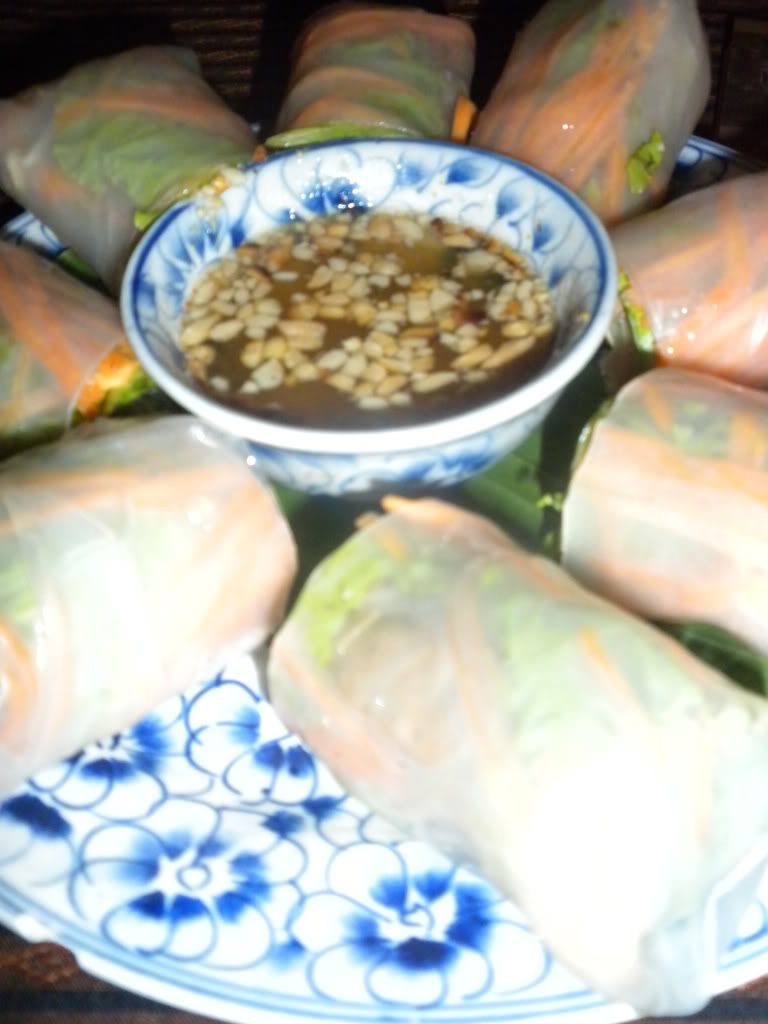
The following day we had 2 more museums we wanted to see, so we arranged for another tuk-tuk driver to take us around. Our first goal, the Landmine Museum was a good 40 kilometers outside of town. It took nearly an hour to get there!
The Landmine Museum is a private museum, set up by Aki Ra, an ex-Khmer Rouge and ex-Cambodian National Army soldier. He was told his parents were killed by the Khmer Rouge and was taken by them to lay landmines, learning much about them in the process. In 1987 Aki Ra defected and joined the Cambodian National Army. He was trained as a deminer, and has been working all over the country clearing land of mines. His complex now also houses victims of landmines, whom he teaches English and other skills.
The museum was quite small, with a few shacks with a mangle of war-artifacts, eye-witness reports, photos and history lessons. In the middle of the open air compound stood, surrounded by a small moat, a glass cage filled with dismantled mines and bombs. The museum also had a small patch of mined land, where we had to look carefully to find several kinds of mines. Inside the adjoining shack we saw pictures of said mines.
A selection of army gear and clothing from the Khmer Rouge, the Cambodian National Army through the years, complete with another large stack of guns and mines, stood just outside of this shack. We got to try some of the gear inside the next shack, where Francesca put on a slightly oversized helmet. She looks war-ready, doesn’t she? We read about the very basic way in which mines are found: carefully poking in the ground with sticks or knives, before carefully unearthing the find. We also learned about the basic ways in which some of the mines are set off: look at the picture below and tell us that that looks safe!
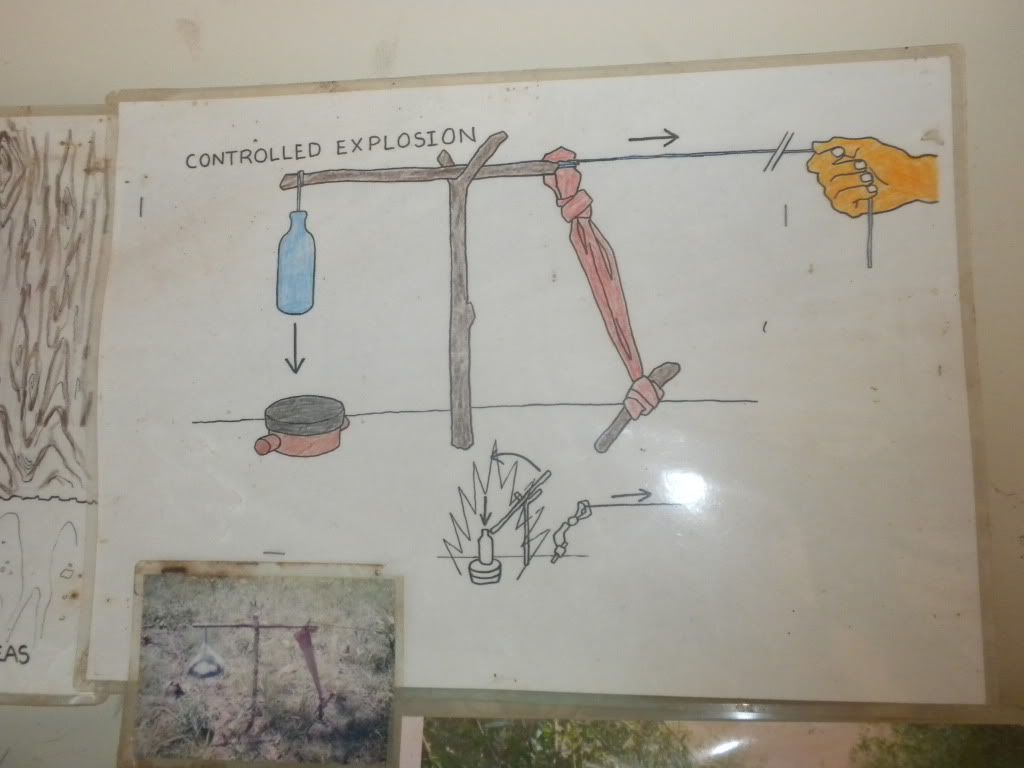

The next shack finally told us the history of the war in Cambodia. I will teach you all another history lesson, so sit tight! After gaining independence from the French in 1953 the country was headed by Prince Sihanouk. From 1964, the Sihanouk government faced an underground Marxist movement called the Khmer Rouge. The Khmer Rouge overthrew the government in 1970 and pledged to remove foreign communist forces, which appealed to the United States. Backed by the US the Khmer Rouge seized control of Phnom Penh in 1974, and subjected the country to a radical attempt at social re-engeneering. Towns were evacuated, intellectuals were rounded up and killed and the rest of the population was subjected to forced labor in the countryside. More than a million people died from torture, disease and starvation. In 1977, it was officially acknowledged that the country was being run by the Communist Party of Kampuchea (say it out loud!), led by Pol Pot.
The Cambodians were eventually saved by the Vietnamese in 1978, when they invaded and captured Phnom Penh. People got their freedom back and Pol Pot and his Khmer Rouge were pushed towards the Thai border. Here they made a stand for many years to come. In 1989 the Vietnamese withdrew, leaving Cambodia a reborn nation with a new flag, new name and Buddhism as its reinstated religion. The Khmer Rouge fought back with guerilla tactics, but was finally defeated when Pol Pot was denounced by his former comrades in 1997. He was sentenced to house arrest due to his failing health and died in April 1998.
Interesting, huh? Did you know any of this? We sure didn’t! What was even more shocking to read for Francesca was the US’s involvement in all of this: In October 1965 President Johnson ordered the bombing of the Ho Chi Minh trail (which I talked about in the Phonsavan-post). It was the start of nearly 10 years of continual bombing of Cambodia. Nearly 60.000 missions were flown in those years, and hundreds of thousands of bombs still litter the countryside. At the time the bombing cost the lives of 600.000 Cambodian civilians, and actually helped the Khmer Rouge come to power. But even today people still step on bombs, and like in Laos, many children are the victims.
We watched a short documentary about the aforementioned, before leaving the Landmine Museum, thoroughly impressed. Little did we know the next museum would have a very similar effect. Francesca had read about the War Museum on TripAdvisor, but we couldn’t find it on any of the tourist maps. Even when we asked locals people weren’t entirely sure. Luckily our tuk-tuk driver knew where to go and took us to there.
After going down a dirt road Francesca and I found ourselves the only two visitors to the museum. We were met by the owner Sna, who also functioned as a guide. As he let us through his open air museum he told us his saddening life story.
Sna was born in 1979, and lost his family early in on life as they were killed by the Khmer Rouge. He was raised by his uncle, and stayed with his uncle, who joined the Vietnamese Army to fight the Khmer Rouge. He told us he saw many scary things. He remembers how he found a ‘toy’ in the forest when he was 8. The toy turned out to be a fuse, and the bomb exploded in his hand. He lost three fingers and lost 20% sight in one eye due to flying shrapnel.
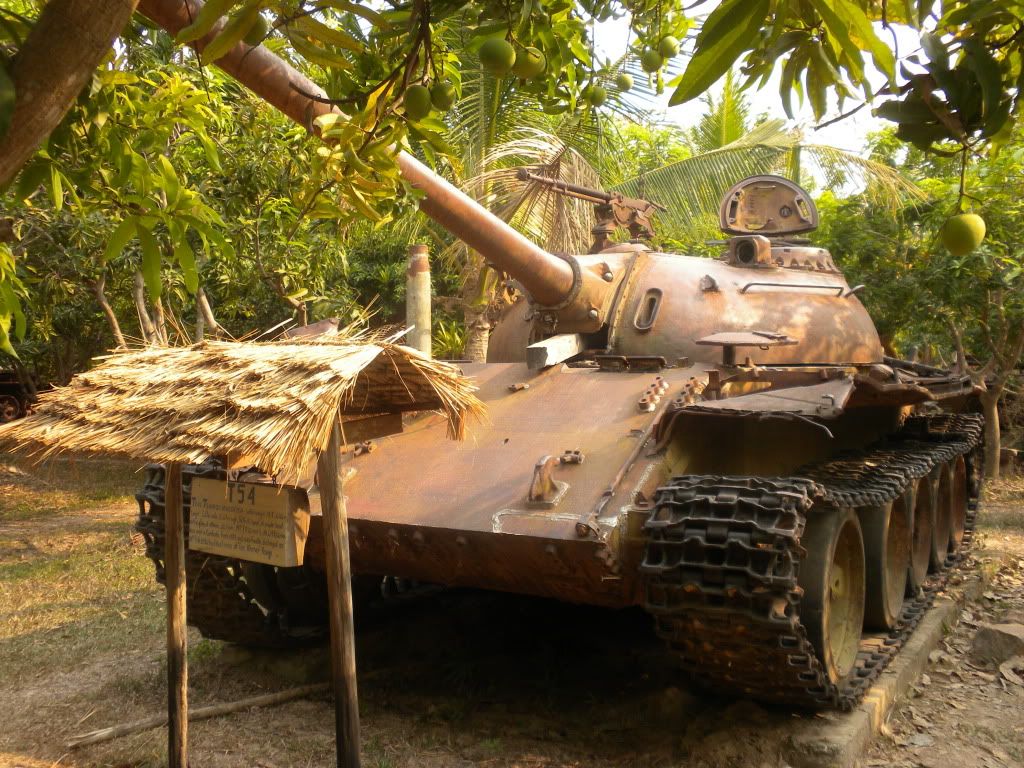
Another story he told us took place when he was 21 and walking through the forest with 2 friends. One of his friends stepped on a landmine. His two friends died on impact, whilst Sna, who had been a little behind, was once again hit by shrapnel. Cambodian soldiers came to his aid, operating on him on the spot without anesthesia. He still has shrapnel in his thigh from the incident. The same year his uncle passed away as well, leaving Sna all alone. In an attempt to make money he set up the museum, buying and gathering up vehicles and guns, telling his story to interested visitors.
Francesca and I saw him tear up during some of his stories. We thought it courageous of him to face his demons on a daily basis. Another sad thing: the government won’t help him with his museum, because the war is not something you’re supposed to talk about openly. He remained weary throughout the entire tour, looking around for anyone that might hear him talk to us. He started talking softer when our tuk-tuk driver came to look for us. He also said he needs to have security around his house at night, fearing for his life. We made a small donation to hopefully bring him a little closer to surgery.
Anyway, back to the museum. Sna had an impressive collection of vehicles. He showed us an old T54 tank, slowly rusting away amidst fruit-bearing trees. The tank had been in use up until 1994, finally being destroyed by a mine. We had a look inside, before moving on to Sna’s impressive gun-collection. We got to see and hold weapons from all sides of the battle: American BARs, Russian and Chinese AK47s, Russian PPSHs, Rambo-esque machine guns, and even a bazooka.


What hurt Sna the most was his epilogue about mines. He showed us the different mines, made by Russians, Americans, Chinese and even Vietnamese producers. Most impressive was the MON-50, an American mine that is set up with a nearly invisible tripwire. When set off the mine explodes in one direction, literally shooting out hundreds of pieces of metal. We saw the inside of the mine and realized the tiny shrapnel must act as bullets, killing many people in one go. We also learned about ‘hanging mines,’ which and wooden mines, both made to evade metal detectors.
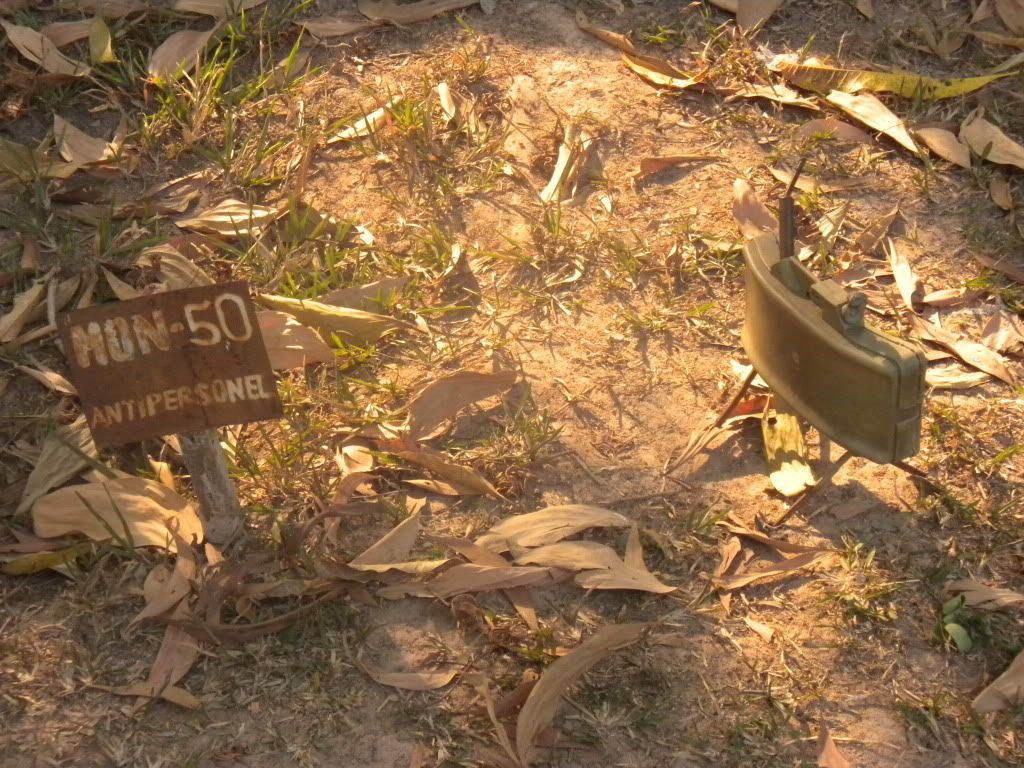

The rest of the grounds held more anti-air guns, old Russian rocket launchers and other artillery. A small section was dedicated to pictures. Sna told us to have a good look, whilst he walked away, not being able to see pictures of his killed friend. We had another long talk with him after the tour, and he told us something we did not know: the leader of the Khmer Rouge Pol Pot’s real name is Saloth Sar. He took the name "brother number one" and declared his ‘nom de guerre’ (war name) Pol Pot, from ‘Politique Potentielle,’ the French equivalent of a phrase supposedly coined for him by the Chinese leadership. You learn something new every day!
We said our warm goodbyes to Sna and had a quick look at the Cultural Village, something Francesca had been looking forward to. However, the park was about to close and we didn’t want to waste money on the steep entrance fee that day. We went back to the Shadow and once again ate dinner in the room. Ah, the bliss of roomservice!

1 Comments:
Hallo, Wat een interessant verhaal. Het is allemaal haast niet te bevatten,wat daar allemaal gebeurt is. Wij hebben in die tijd er ook wel overgelezen,maar hoe dat allemaal ging, daar heb je geen weet van.En die foto,s, Die helm staat je goed Francesca. Heel stoer met die geweren, ook jullie. Ik geniet er van. Je hoort wel weer van mij. Groetjes Omaxxxx
Post a Comment
<< Home